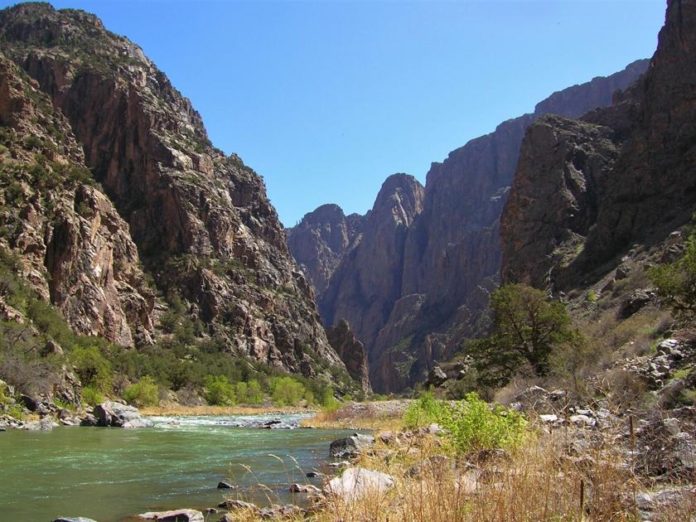Early morning quiet seems to permeate the atmosphere along the river in Black Canyon National Park. The Gunnison River’s flows are diminished after years of drought and the rapids lack their usual thunder. Box elder and juniper trees shade the river’s shore. I look for rainbow trout in the clear running water, but they do not show themselves.
Trout are highly sought after by anglers during the most prolific of insect hatches (stone fly) which typically occurs from late-May to late-June. It’s no matter for me. My fly fishing skills are poor and the fish are completely safe from my abilities. But their presence in the Gunnison, one of the most coveted fly fishing streams in North America, provokes questions about them and us.
I soak my feet in Gunnison’s waters and think on fish. Among all animal species that have a backbone, fish lead the way — arising some 530 million years ago. Rainbow trout, as we know them, are a relatively new species among fish. They evolved as glaciers of the Wisconsin episode retreated some 40,000 years back.
The rainbow trout (Oncorhyncus mykiss) arose in lakes and rivers of the Pacific Northwest and particularly the Columbia River drainage before and after glaciation. There are six subspecies of the rainbows, all of them sought by anglers.
Gravel bars in the Gunnison River provide spawning beds for adult trout at two to three years of age. Several thousand eggs can be laid (per female), and fertilized, but almost none of them will survive to the fingerling stage. Although this isn’t unusual for trout and its part of their biological process, it seems like a lot of effort without much to show for it.
The first rainbows were transferred from California to the Gunnison, near Sapinero, in 1888. Within 10 years, an angler hooked a 12 pound fish near the town of Gunnison. Brown and brook trout were also brought to the Gunnison which scrambled the fishery.
Part of the problem in the Gunnison is that whirling disease was introduced to its waters more than 30 years ago. Wildlife officials and fisheries biologists at Colorado Parks and Wildlife (CPW) made heroic efforts to rescue the crashing population in the early 1990s. You can read about their ongoing effort online.
Over the decades, predators and the unruly habitat pushed the rainbows into an increasingly wild character. CPW biologists stepped into the cause of saving the fish below Crystal Dam because this 100-year strain of fish is unusual to find. The Gunnison River takes on a rowdy nature when it floods, and this pushes the rainbows to their limits.
The rainbow trout is the energizer bunny of the Gunnison River. Check out any household battery. They are all pretty much 1.5 volts (unless it’s the rectangular 9-volt battery). The trick with these batteries isn’t that they have unlimited power, but that they are available for long periods of time — whenever you need them to work.
The Gunnison River, since 1888, has tremendous floods, often well over 10,000 cubic feet per second (cfs). If you filled a basketball with water, that would be a close equivalent to just one cubic foot.
At 12,000 cfs the river expends more than 2.75 million horsepower. Compare that to a brand-new Ford F-150 pickup at 400 hp. Rainbows have adapted to river velocities by swimming lower in the water column or catching the upstream end of eddies or pools that lie along the river’s edge.
The river never stops. Even with the dams upstream, the Gunnison current never ceases. Same for the trout. They flip between holding positions and feeding positions (they eat a lot), but they are always in the flow. For them, life is a balance between energetically efficient foraging and making use of the river flow to provide for some rest. They are always in motion, always energized.
It’s still early morning down along the Gunnison. I pull my feet out of the water, energized by the bracing temperature and dynamic current. Wild rivers can infuse us with such vitality and along with the Gunnison, we have many other area streams where feet can be soaked.
Yet, I wonder about this energy of life between fish and river. And maybe those anglers have it right. Being in touch with a living creature, made stronger and wilder by such a river should remind us that, like the energizer bunny, we also can “…keep going, and going, and going.”
Paul Zaenger has been a supervisory park ranger at Black Canyon of the Gunnison National Park since 1993. Other park assignments include Mount Rushmore National Memorial and Glen Canyon National Recreation Area.
Credit: Source link































